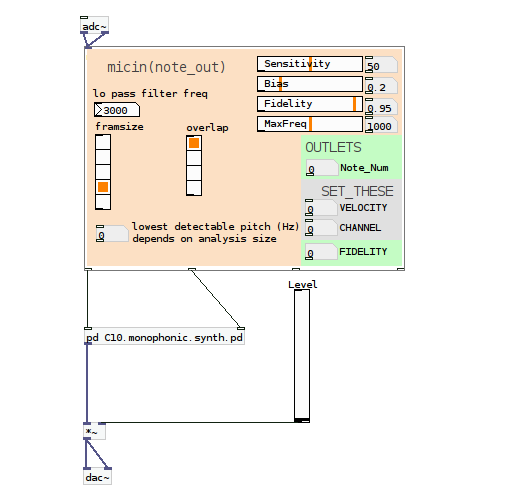[micin~_abs]
The [micin~] abstraction reads an incoming signal and reports the derived (via Katja Vetter's helmholtz~ external) note number, (and what the user sets for) velocity and channel number.
Thereby (most espaecially) allowing patches which take [notein]'s as their source to also take the mic.
Most practical application: being able to run non-midi instruments, ex. guitars, thru synthesisers and so use them as pedals.
micin~, Scott Vanya 2016
included in the zip below is:
/ext : the [helmholtz~] external as a zip file
/synth : the 1.poly.synth.pd used in example2
example1.pd : a simple example using C10.monophonic.synth.pd from Help>Pure Data>docs>audio examples
example2.pd : a more complex example also using the pd help files under >stuff
helmholtz_license
micin~.pd : the abstraction
micin~.png : the image inserted below, showing example1
msg.txt : this message.
Please, let me know if there is something I was foggy in my logic about this, or have not made clear in the example.
The helmholtz~ tool is awesome and really great and fast at doing this, I basically just cleaned it up and abstracted it.
On the other hand, I have already incorporated it into quite a few synth effects for use with my guitar, aka. see "jazzed" for how excited I am to get back to the studio.
-peace and good will,
svanya

CREDITS:
[helmholtz~]
from: http://www.katjaas.nl/helmholtz/helmholtz.html
[helmholtz~] pitch estimator for Pure Data, written by Katja Vetter, Feb 2012
developed and tested against Pd-extended 0.42-5
[helmholtz ~] uses the Specially Normalized AutoCorrelation function (SNAC), developed by Philip McLeod. For more information about SNAC, see article and thesis by Philip McLeod:
http://miracle.otago.ac.nz/tartini/papers/A_Smarter_Way_to_Find_Pitch.p/Developer/4puredata/helmholtz~/README.txtdf
http://miracle.otago.ac.nz/tartini/papers/Philip_McLeod_PhD.pdf
